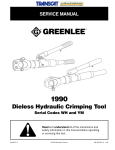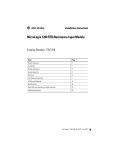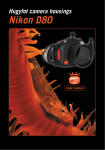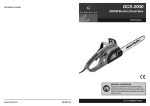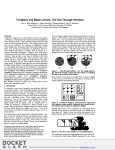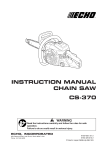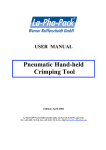Download BROCHURE Applicators (English)
Transcript
Catalog 296393-2 Revised 02-06 Applicators Fast Facts TE Connectivity applicators with reliable, long-life quality and construction for a vast variety of terminals from TE and other manufacturers: • Versatile applicators for sideor end-feed terminals • In-stock selection for over 5,000 terminal types • Special designs to meet unusual and international requirements • Highest quality replaceable crimp tooling • Flexible plans for ownership or rental • Options for fast, costeffective troubleshooting and service Selection, Use, Maintenance, and Troubleshooting for Maximum Productivity Applicators and tooling, from TE Connectivity, can be your key to productive, profitable wire harness manufacturing. These applicators come from a long tradition of quality, reliability, and precision. Manufactured from high grade tool steels, and processed through stateof-the-art CNC equipment for tightest tolerances, TE applicators are made for high repeatability and fast throughput. Every piece goes through an exhaustive test and calibration process, with each one shipped with test samples verifying operation and full documentation for operation, adjustment, and maintenance. TE Connectivity offers an unmatched selection of applicator styles and terminal types, with configurations for both TE and other manufacturers’ terminals. Styles are available for nonTE terminating machines from both domestic and foreign sources. At TE we do more than supply the world’s leading applicators. We provide service, technical support, and maintenance and repair, both on site and at our service centers. We know how critical reliable production is, and our products and services are committed to keeping your production running. We also recognize that your needs may change quickly, so our extensive selection of applicators is available in flexible purchase and rental plans. With these choices, you can manage your costs while maintaining the capacity and capability you need. Applicators Keys to Quality Crimping Crimping Conditions Crimp connections are the standard in industrial manufacturing, maintaining good connection under extreme mechanical, thermal, and environmental conditions. Successful crimping results from the correct relationship between wire, terminal, and crimping tool. Once the terminal selection is made and crimping criteria defined by the connection designer, the tooling characteristics are fully determined. lead-processing systems can incorporate varying degrees of automation, from one-at-a-time machines, with wires hand-fed, activated by an operator-driven foot switch to fully automated leadmakers that cut and strip the wires, and feed wires and terminals. Applicators are configured by TE according to the wire and terminal type, and in some cases, by the terminator specifications. These conditions are realized in: • Wire—conductor section and insulation diameters and material Successful crimping results from the correct relationship between wire, terminal, and crimping tool. • Terminal—conductor and insulation barrel crimp styles and dimensions • Crimping equipment—settings for wire and insulation crimp height, feed parameters, and adjustments Summarizing, the conductor crimp ensures a good connection between the wire and the terminal. The insulation crimp supports the wire to reduce the effects of vibration and movement on the conductor crimp. Terminals to be crimped in automatic equipment are generally supplied in continuous strips (shown here) or, in some cases, as loose pieces. Accomplishing the Desired Crimp Terminal type and wire parameters depend on the production requirement. Both open barrel and closed barrel terminals are supplied on continuous strips. Crimping is performed by an applicator, a mechanism that performs the functions of feeding the terminal, cutting the terminal from the strip, and crimping wire and insulation. Crimping force is provided by a terminator in which the applicator is mounted. Terminators and other A terminator provides the crimping force for the applicator installed within. Applicators are built for specific terminal and wire sizes and feed arrangements. Need More Information? 2 Catalog 296393-2 Revised 10-2011 For information about tooling, call 888-777-5917 or 717-810-2080; email: [email protected]. For drawings or technical data, contact your TE Connectivity sales engineer or call the Technical Support Center: 1-800-522-6752. Dimensions are in millimeters unless specified otherwise. Values in brackets are English equivalents unless specified otherwise. Specifications subject to change. Consult TE Connectivity for latest specifications. Applicators Common Crimp Forms A brief review of common wire and insulation crimps indicates the variety of crimping requirements that can be implemented in TE Connectivity applicators. F-CRIMP F-crimp The most common crimp form. Features a U-shaped open barrel, which is closed during the crimp cycle, pressing tightly together with the conductor. This form is also common as an insulation crimp. TAB-LOK An asymmetrical terminal, useful when there is only a narrow space available for the terminal. Incorporates a locking tab to support the asymmetric forces when it is in use. W-crimp Tab-Lok W-CRIMP Common with metallic closed crimp barrels for both stranded and solid conductors. C-crimp C-CRIMP A metallic closure with plastic barrel on top of it—provides good support for insulation. Overlap Crimp OVERLAP CRIMP Insulation crimp suitable for leads with thin-walled insulation. WRAP-OVER CRIMP Wrap-over Crimp An insulation crimp in which the crimp ends “interlace,” completely enclosing the insulation. O-crimp O-CRIMP Useful for processing individual seals. Need More Information? 3 Catalog 296393-2 Revised 10-2011 For information about tooling, call 888-777-5917 or 717-810-2080; email: [email protected]. For drawings or technical data, contact your TE Connectivity sales engineer or call the Technical Support Center: 1-800-522-6752. Dimensions are in millimeters unless specified otherwise. Values in brackets are English equivalents unless specified otherwise. Specifications subject to change. Consult TE Connectivity for latest specifications. Applicators Crimp Tooling — A Critical Element for a High Quality Crimp The crimp tooling—the actual crimper and anvil that are in contact with the wire and insulation—is one of the most important factors in meeting crimp quality specifications. TE Connectivity quality tooling is proven through years of experience to achieve superior performance. Four aspects of the crimp tooling have the maximum impact. The connection designer selects a terminal and crimp parameters that achieve the desired reduction in Area Index. 1. Geometry and Associated Tolerances Terminals are designed to perform to specification only when the final crimp form is within a narrow range of dimensions. Controlling critical crimp dimensions is influenced by many factors including: • Wire size and material variation • Terminal size and material variation • Equipment condition The final quality and consistency of a crimp can never be any better than the quality and consistency of the tooling that is used. If other variations could be eliminated, tooling can and should be able to produce crimp forms that are well within specified tolerances. Also, variation from one tooling set to another should be held to a minimum. Crimp tooling features that are well controlled and exhibit excellent consistency from tooling set to tooling set can result in shorter setup time as well as more consistent production results. Proper crimper and anvil design provide necessary clearances without excessive tolerances that can lead to flash and other crimping errors. (a) terminal is plastically deformed and extruded to complete the termination. The anvil experiences some of the same conditions but to a much lower level of severity. Specific material characteristics bearing on the crimp process include the toughness to withstand the shocks generated during crimping and sufficient wear resistance to maintain dimensional tolerances. 3. Surface condition Surface condition can affect the performance of the crimp tooling as well as the longevity of service. A hard, smooth surface improves adhesive wear properties and, thus, increases service life. The other attribute that needs to be considered is friction. Friction is a contributing factor in determining the final crimp form and process characteristics. Low tooling friction results in lower crimping force and thus can influence crimp form as well as tooling life. Consistent frictional characteristics between tooling sets reduces process variation. 2. Material (b) Significant flash can be generated with excessive anvil-to-crimper clearance, as illustrated by nominal-design condition (a) and +0.003 in over nominal condition (b). The wire crimper and the anvil have different functional demands. Both have the need to withstand high loads and moderate shock. However, the wire crimper is in fact an aggressive forming tool. It must withstand high shear loading that is a result of frictional loads generated as the terminal barrel slides along the crimper surfaces in the forming process, and then as the barrel Need More Information? 4 Catalog 296393-2 Revised 10-2011 A polished, lubricated crimper surface reduces friction and the associated material buildup. For information about tooling, call 888-777-5917 or 717-810-2080; email: [email protected]. For drawings or technical data, contact your TE Connectivity sales engineer or call the Technical Support Center: 1-800-522-6752. Dimensions are in millimeters unless specified otherwise. Values in brackets are English equivalents unless specified otherwise. Specifications subject to change. Consult TE Connectivity for latest specifications. Applicators 4. Surface Treatment A commonly accepted approach to improved crimp tooling performance and life has been to apply a surface treatment to the crimp area. Applying an appropriate surface treatment to the wire crimper will have the most benefit to crimp performance and tooling life. No buildup of material is visible on a chromium plated crimper surface after 100,000 terminations. An example of an effective treatment is chrome plating. Chrome plating has a very low coefficient of friction, so there is less tendency for terminal distortion. It also has greater surface hardness, reducing adhesive wear. Finally, the plating enhances resistance to adhesion and cold welding, so there is no buildup of material transferred from the terminal that can cause incorrect crimps on subsequent operations. Material buildup in the crimper results in gross deformation of the crimped terminal. Determining Crimp Quality Note significant buildup of material on an unplated crimper surface after only 60,000 terminations. Crimp height can be measured using a micrometer with appropriately shaped jaws. The connection designer, having once specified the wire and terminal type, also defines the crimp parameters. The critical characteristic is the area reduction of the wire during the crimp. A quality crimp must achieve the required area reduction, without inducing conditions, such as flash, overor under-crimp, or bending, which can compromise the reliability of the connection. Beyond visual inspection, the traditional test is pull-out force. This is a gross measure of crimp quality, and may be difficult to perform on a 100% basis in a production environment. Material buildup on the crimper results in visible deformation of the outer crimp surface in this example. Crimp height can be tested with a micrometer that has been fitted with appropriately shaped jaws. More effective is the TE Crimp Quality Monitor (CQM), which can be installed on the terminator to provide real-time, 100% measurement. Crimp force has also been used as a measure, but by itself does not provide the data required. The TE Crimp Quality Monitor uses sensors mounted on the terminator ram to combine crimp force and ram position in a calculation of crimp height on a realtime basis. Driven by the requirements of 6-Sigma and other international quality standards, TE has developed crimp height measurement testing technology, which provides dependable, non-destructive, evaluation of 100% of crimped terminals without impact on production throughput. Crimp height measurement is a well established methodology and, in combination with crimp force measurement, is superior to destructive methods, sampling methods, or techniques that depend on crimp force alone. Need More Information? 5 Catalog 296393-2 Revised 10-2011 Actual real-time measurement of force vs. ram position shows a good quality crimp. For information about tooling, call 888-777-5917 or 717-810-2080; email: [email protected]. For drawings or technical data, contact your TE Connectivity sales engineer or call the Technical Support Center: 1-800-522-6752. Dimensions are in millimeters unless specified otherwise. Values in brackets are English equivalents unless specified otherwise. Specifications subject to change. Consult TE Connectivity for latest specifications. Applicators Quality Applicators — Making the Right Choice End-Feed or Side-Feed — A Terminal-Driven Decision Feed Determined by the Terminal Supply. The two main classes of terminal feed are side feed and end feed. This determination depends on the terminal geometry, stamping process, and other factors in the terminal manufacture. In both cases, the terminals are supplied in a continuous strip, coiled on a reel. In the side feed applicator, the applicator feed strip moves perpendicular to the axis of the individual terminals, from side to side with respect to the operator. End feed terminals move from the back of the applicator toward the operator, barrel first for manual wire insertion. For side feed, where the terminals move (typically) into the applicator from the operator’s left to right, the terminals are formed attached to a carrier strip that includes feed holes spaced with the same pitch as the terminals on the strip. The axis of the terminals, i.e., the direction that the wires are inserted for crimping, is perpendicular to the feed direction, so the terminals are parallel on the strip. As part of the crimp process, the terminal is cut free from the strip, which is discarded. For end feed, the terminals enter the applicator from the rear and move toward the operator, barrel end first. In this case, the terminals are aligned with the direction of motion, and have blank metal between the front edge of one (the crimp end) and the rear edge (the trailing, terminal end) of the next. There is no separate carrier. As part of the crimping process, this small blank piece of metal, or “slug,” is cut out and discarded. (a) (b) Side feed terminals (a) are made on a single or double carrier strip. End feed terminals (b) are often supplied when the design would use too much metal or have too great a pitch if made as side feed. Pre-Feed or Post-Feed In post-feed applicators, the terminal is positioned for crimping after the operator activates the switch. In pre-feed applicators, the terminal is positioned prior to crimping. This is particularly useful for closed barrel terminals, so that the operator can more easily insert the wire end. Need More Information? 6 Catalog 296393-2 Revised 10-2011 For information about tooling, call 888-777-5917 or 717-810-2080; email: [email protected]. For drawings or technical data, contact your TE Connectivity sales engineer or call the Technical Support Center: 1-800-522-6752. Dimensions are in millimeters unless specified otherwise. Values in brackets are English equivalents unless specified otherwise. Specifications subject to change. Consult TE Connectivity for latest specifications. Applicators Choosing an Applicator Ocean Applicator Series With the knowledge and experience of over a half century designing and manufacturing world leading applicators and tooling, TE Connectivity is taking terminal crimping to a new level. Using the time proven HDM and HDI applicator platforms as a base and the innovation and improvements from the System III Applicator, TE is taking a large step forward. TE has listened to customer input and market demands to innovate and improve the combined strength of these industry leading designs to create the new Ocean Applicator. The lead and harness industry of today is more price and quality competitive than ever before. Crimping standards continue to be raised to higher levels of quality and repeatability. The industry continues to expect more from application tooling. The new Ocean Applicator Series was designed specifically to exceed the requirements of today and meet the demands of tomorrow. By consolidating our applicator offering to this new Ocean Applicator, TE can provide design consistency and tooling standardization to the market. One of the major benefits to the customer is offering the ultimate flexibility with a choice of feeding options: New and improved Mechanical and Pneumatic feeds combined with the innovative and precise Servo Feed option. The Ocean Series design makes it possible for customers to perform field upgrades to System III technology. It will provide an upgrade path for terminal intelligence that allows the machine to obtain set-up features as the applicator is upgraded. Request Catalog 4-1773460-5 for more information about the Ocean Applicator Series or view it online at tooling.te.com/applicator.asp One Applicator Platform — Modular Family Design • 2 ram interface styles (“Atlantic” or “Pacific” style ram collar) • Same wire crimper, insulation crimper, and anvil used on both applicator styles • 3 feed options — • Mechanical • Pneumatic • Servo • Same feed units can be used on Side-Feed and End-Feed style applicators. All units can be easily removed and interchanged for upgrades if desired. Atlantic-Style SF Servo Atlantic-Style SF Pneumatic Atlantic-Style SF Mechanical Pacific-Style SF Servo Pacific-Style SF Pneumatic Pacific-Style SF Mechanical Need More Information? 7 Catalog 296393-2 Revised 10-2011 For information about tooling, call 888-777-5917 or 717-810-2080; email: [email protected]. For drawings or technical data, contact your TE Connectivity sales engineer or call the Technical Support Center: 1-800-522-6752. Dimensions are in millimeters unless specified otherwise. Values in brackets are English equivalents unless specified otherwise. Specifications subject to change. Consult TE Connectivity for latest specifications. Applicators Standard Features on all Ocean Applicators One of the major design goals of the Ocean Applicator Series was increased flexibility. By giving the applicator the ability to flex between different terminator configurations it allows customers to quickly adapt their applicators to whatever configuration is needed. All parts to reconfigure the applicator are included and attachable to the unit for safe storage and quick access. As standard equipment the new applicator will have all the accessories needed to switch between 30 and 40mm stroke terminators, pre-feed and post-feed cam configurations and cut and no-cut carrier options. The wire stop / wire stripper can also be easily adjusted for the desired applications, and a mechanical counter is included for tracking cycle counts. The applicator comes with all parts needed to configure it to any terminating method that is acceptable to the application. Standard Features • Pre-feed and post-feed cams • Cut and no-cut carrier options • Adjustable terminal stripper • Adjustable spring-loaded terminal hold down • Mechanical counter • Fine adjust crimp height mechanisms Ocean Applicator Part Number System Because so many features have been added to the new applicator the part numbering system used to identify the applicators can be simplified significantly. Now, when ordering a new applicator the customer will only need to identify what style and feed type they require. Part Number System Atlantic Style Pacific Style Feed Type Description Part Number Mechanical Fine Crimp Height Adjust 2151054-1 Pneumatic Fine Crimp Height Adjust 2151054-2 Servo Fine Crimp Height Adjust 2151054-5 Servo Non-Crimp Height Adjust* 2151054-6 No Feed Fine Crimp Height Adjust 2151054-7 Spare Parts Kit 7-2151054-7 Feed Type Description Part Number Mechanical Fine Crimp Height Adjust 2-2151054-1 Pneumatic Fine Crimp Height Adjust 2-2151054-2 Servo Fine Crimp Height Adjust 2-2151054-5 No Feed Fine Crimp Height Adjust 2-2151054-7 Spare Parts Kit 7-2151054-8 * Non-Crimp Height Adjust Applicator is designed to run in a terminator with System III Crimp Height Adjust Technology. Need More Information? 8 Catalog 296393-2 Revised 10-2011 For information about tooling, call 888-777-5917 or 717-810-2080; email: [email protected]. For drawings or technical data, contact your TE Connectivity sales engineer or call the Technical Support Center: 1-800-522-6752. Dimensions are in millimeters unless specified otherwise. Values in brackets are English equivalents unless specified otherwise. Specifications subject to change. Consult TE Connectivity for latest specifications. Applicators Crimpmatic 970 and 971 Machines Pneumatic Large Wire Applicators (for Strip Form Terminals) The CRIMPMATIC 970 can process loose or reeled terminals for wires up to 16mm2 [51/2 AWG]. Working with even larger size wires? The CRIMPMATIC 971 can handle all the way up to 50mm2 [0 AWG]. But automating the crimping process isn't the only benefit. Crimping is faster and more reliable. So your crimping process will be safer and more productive, with higher-quality finished products. • Dedicated to Crimpmatic 970 / 971 Both CRIMPMATIC models come in a space-saving design, have an inching mode for setup, include a reel holder for spooled terminals, and allow twohanded operation for the application of loose piece terminals. You can even order the following options: • For terminators with standard AMP-style base plate (4 to 8 tons) and Crimpmatic 970 with base plate for conventional applicators. • Crimp force monitoring • Wire Range: up to 40, 0mm2 • Fine Adjustment • Press Stroke: 44,0mm • Shut Height: 158,0mm • Applicator Feed: up to 50,0mm (pre-feed/post-feed) Pneumatic Large Wire Applicator Pneumatic Mid-Size Wire Applicators (for Strip Form Terminals) • Wire Range: : up to 25,0 mm2 (maximum) • Fine Adjustment • Press Stroke: 40,0mm • Shut Height: 135,8mm • Fine adjustment of lower dead center • Applicator Base Plate: Conventional Base Plate (TE-style) • Paper spooler • Applicator Feed: up to 50,0mm (pre-feed/post-feed) Pneumatic Mid-Size Wire Applicator Loose Piece Large Wire Applicators • Dedicated for Crimpmatic 970 / 971 • Wire Range: up to 40,0mm2 • Fine Adjustment • Press Stroke: 44,0mm • Shut Height: 158,0mm • Moveable table with dedicated terminal seat (according to terminal geometry) to load and unload terminals Crimpmatic 971 • Stroke: 40 to 50mm • Custom designs available for nearly any terminal Note: All loose piece applicators have a micro switch installed at the end of the moveable table stroke. This allows it to be connected in the terminator electrical system for preventive safety. Loose Piece Large Wire Applicators Crimpmatic 970 Need More Information? 9 Catalog 296393-2 Revised 10-2011 For information about tooling, call 888-777-5917 or 717-810-2080; email: [email protected]. For drawings or technical data, contact your TE Connectivity sales engineer or call the Technical Support Center: 1-800-522-6752. Dimensions are in millimeters unless specified otherwise. Values in brackets are English equivalents unless specified otherwise. Specifications subject to change. Consult TE Connectivity for latest specifications. Applicators Selecting the Applicator for Your Requirements A convenient lookup function on the TE web site will guide you through applicator selection and provide access to all necessary documents and drawings. 1. Use your web browser to go to http://tooling.te.com/applicator.asp. 2. Under More Information, click on the link called “Tooling Cross Reference”. 3. Enter the part number of the terminal in the indicated box and click on Search. 4. On the resulting Part Detail page, click on the Tooling link in the Related Part Information section. This page also gives complete information on the selected terminal, with links to drawings, specifications, and other documents. 5. Click on your geographic region. You will be taken to a page that gives references to appropriate applicators, including references for selecting an applicator for use in a particular terminator, with documentation and drawings. 6. If you do not find an applicator to meet your requirements, contact your TE sales engineer or the Technical Support Center at 1-800-522-6752. Applicators for Non-TE Terminals 1. Use your web browser to go to http://tooling.te.com/applicator.asp. 2. Click on the link called :”Applicators for non-TE Terminals”. 3. Use your browser’s Search function to find the terminal you need to crimp. 4. If you do not find an applicator to meet your requirements, contact your TE sales engineer or the Technical Support Center at 1-800-522-6752. Finding Applicators by Part Number Search Go to: www.tooling.te.com/europe/applicator.asp This powerful search application allows you to search by terminal or applicator part number. Simply enter the part number, select a manufacturer from the drop-down box and our application will display a comparative array. Additional information is available via hypertext including the specific PN’s required for the different application options. Need More Information? 10 Catalog 296393-2 Revised 10-2011 If you don’t find what you need, that does not mean that there is not anything available for your application. Call 888-777-5917 or 717-810-2080 for personal assistance or email: [email protected]. The data in this application is updated on an ongoing basis. For information about tooling, call 888-777-5917 or 717-810-2080; email: [email protected]. For drawings or technical data, contact your TE Connectivity sales engineer or call the Technical Support Center: 1-800-522-6752. Dimensions are in millimeters unless specified otherwise. Values in brackets are English equivalents unless specified otherwise. Specifications subject to change. Consult TE Connectivity for latest specifications. Request for New Applicator Quotation Company Name Customer Contact Title Address City State ZIP Code Phone Number Country Fax Number TE Connectivity Customer Acct Number E-Mail Address Choose one of each category: Ram Type: ❏ ❏ Type of Terminal: ❏ TE Terminal ❏ Pneumatic ❏ Servo Terminator Stroke: ❏ 30mm ❏ 40mm Crimping Machine: ❏ Leadmaker ❏ Bench Large Wire Terminator: ❏ 5 Ton ❏ 16 Ton Feed Type: ❏ non-TE Terminal ❏ Mechanical For non-TE Terminal Use: Crimp Specification Information: Terminal Manufacturer: Indicate crimp specification dimensions and tolerances: Manufacturer’s Part Number: Open Barrel (include additional info) Terminal to be inserted into housing? Seal or grommet to be applied? ❏ Yes, Part # ❏ Yes, Part ❏ No ❏ No Carrier Strip Type: ❏ End-to-End Wire Crimp: W = ± W = ± ❏ “F” Type ❏ “O” Type ❏ Front Insulation Crimp: ❏ Rear ❏ Front and Rear ❏ “F” Type ❏ “O” Type ❏ “OV” Type Reel Feed Direction (with operator facing front of machine): ❏ Rear (End-to-End) ❏ Center ❏ Left-to-Right ❏ Loose Piece (Large Wire) Applicator ❏ Other (Specify & attach terminal drawing) Note: Please list and document any special crimp, cut-off, bend, housing requirements, or special qualification requirements. Wire Gauge(s): Wire Crimp Height(s): Insulation Crimp Height(s) Insulation Outside Diameter(s): Pull Test (Minimum): Wire Quantity Crimped Simultaneously: ❏ Single ❏ Multiple ❏ No ❏ Yes (if yes, order 1424359-1) ❏ No ❏ Yes If Yes, ❏ Pigtail or ❏ Thru Splice Cross Section Analysis: Splice Application? Special Request: Please complete this form in its entirety. All the information is required in order to provide a quotation. Be sure to include contact name for further communication. Submit a copy of this information, product prints, or 5 sample terminals (on carrier strip), and an application specification or 5 properly terminated samples to your TE Connectivity Sales Representative. Note: When an applicator is ordered, 300 terminal samples (in strip form), product prints, application specifications, and (if applicable) 50 seals and one terminal housing must be provided for the final assembly and applicator qualification. Applicators Crimp Quality Monitor II Simply put, crimp height measurement is the best non-destructive way to ensure meeting the stringent mechanical and electrical properties of the crimp. New easy to use, intuitive menus along with enhanced monitoring and graphing lead the improved feature set of the CQM II. Another major enhancement is the ability to use CQM II on non-TE terminators. Basic Analysis Monitoring Versatile: On-screen programmability allows quick, flexible job set-up. Enhanced ability to support the use of USB peripherals such as: flash drives for database backup, saving reports, and updating firmware. It also includes a full library of USB printers for easy printing of the many graph and report options. Precise: Crimp height measurements are repeatable to within 0.12mm (0.0005”) for every crimp analyzed. CQM II is the only crimp monitoring system that offers continuous Crimp Height analysis for every crimp produced. Five different analysis methods monitor the process to the fullest extent. This ensures quality crimps are produced and faulty crimps are detected. Crimp Height Entry Convenient: Setup is simple and fast. Only a few parameters need to be set to get the system up and running. All functions are controlled through the touch screen, with an intuitive easy to use graphical interface. The system walks you through all the required steps to start production. CQM II has more choices to observe and monitor the crimping process than ever before. Analysis Methods The five analysis methods can be used individually or in combination to provide the most flexible and complete coverage of the crimping process. Crimp Height: The crimp height is the measured height of the terminals crimp barrel formed around the wire. Crimps are analyzed to be within the set tolerance zone. Production Crimp Height Work Index: The work index is a value that is used to compare the relative position of a specified section of the crimp curve that occurs while the wire and terminal are compressed. Crimps are compared to historical data to determine pass/fail. The work index is a dimensionless value. Peak Force: The peak force is the maximum force reading that occurs during the crimp, minus the idle force reading. Crimps are compared to historical data to determine pass/fail. The peak force is a relative value. Point-to-Point (P2P): A series of points are established along the crimp curve in the P2P analysis. During production each point is compared to its upper and lower control limits, and if no points are out of their limits the analysis method considers the crimp to be a PASS crimp. FFT Fast Fourier Transform (FFT): The FFT analysis method converts the force profile into its component frequencies. It computes mean and standard deviation for each of the lowest 32 frequencies from the learn crimps updates the mean and standard deviation with each good crimp. If 4 or more frequencies are outside the tolerance limits, the crimp status is FAIL. Otherwise the crimp status is PASS. Need More Information? 12 Catalog 296393-2 Revised 10-2011 For information about tooling, call 888-777-5917 or 717-810-2080; email: [email protected]. For drawings or technical data, contact your TE Connectivity sales engineer or call the Technical Support Center: 1-800-522-6752. Dimensions are in millimeters unless specified otherwise. Values in brackets are English equivalents unless specified otherwise. Specifications subject to change. Consult TE Connectivity for latest specifications. Applicators Continuing Effective Crimp Performance Service While on-site service may appear to be the most convenient, a less expensive solution may be to ship your applicator to our Applicator/Terminator Service Center. Services include: • Warranty Services—with no charge for labor or parts • Calibration Services The Technical Support Center can provide access to telephone troubleshooting, on-site service, or factory-level repair of applicators and electronic equipment. • Equipment Repair—to application specifications • Quick Turnaround • 90-day Warranty on Repairs Technical Tips Feed is Critical Misfeeds are the most common cause of production downtime. Over- or under-feeding can result in premature wear of the crimper, because the terminal contacts the crimper surface in unprotected areas. Tooling Alignment is Crucial Incorrect tooling alignment can mean rejects due to excessive flash or terminals sticking in the crimper and being damaged or bent. It also can reduce tooling life, leading to out-of-specification crimping and premature tool failure. A simple setup procedure, using heavy paper such as that taken from the terminal supply reel, can ensure proper alignment of the crimper to the anvil. This should be performed on a periodic basis, or whenever there are signs of incorrect alignment. The applicator must be capable of repeatable feed distances, or both tool life and crimp quality will be compromised. An over-fed terminal can scrape the entire crimper surface. Be certain that the feed is properly set. Your user’s manual gives the full procedure for feed adjustment. Need More Information? 13 Catalog 296393-2 Revised 10-2011 When the crimper and anvil are not aligned, it is impossible to achieve a good crimp. For information about tooling, call 888-777-5917 or 717-810-2080; email: [email protected]. For drawings or technical data, contact your TE Connectivity sales engineer or call the Technical Support Center: 1-800-522-6752. Dimensions are in millimeters unless specified otherwise. Values in brackets are English equivalents unless specified otherwise. Specifications subject to change. Consult TE Connectivity for latest specifications. Applicators Continuing Effective Crimp Performance Maintenance Keeps You in Production It’s easy to overlook, but routine greasing can be a factor in reducing production downtime. Checking tooling—inspecting crimpers and anvils—before they break also will support production continuity. Correct Shut Height Having all your terminators set to the correct shut height facilitates quick change from one terminator to another. This straightforward adjustment procedure calls for use of a calibrated shut height gauge. If you cannot perform this adjustment, ask your TE field service person to do so. Lubrication — A Simple Step to Reliable Crimping Just as with any machinery, lubrication of the applicator reduces wear and even protects against corrosion. Specific use of contact lubricant on terminals prevents the friction that can lead to sticking in the crimper, bent terminals, and premature crimper wear. Transporting Applicators Safely Although they are manufactured to withstand the impact of crimping, crimpers and anvils do not fare well when they contact each other. Such contact can scrape the plating or the crimping surface, causing a friction point. Such a friction point can form metal buildup, ultimately causing reject crimps and even tool breakage. Proper adjustment of shut height facilitates quick change of applicators into different terminators. This problem is easily avoided. Always leave a terminal in the crimp tooling when moving the applicator from one location to another. This allows the terminal to receive any possible contact and protects the tooling. Need More Information? 14 Catalog 296393-2 Revised 10-2011 For information about tooling, call 888-777-5917 or 717-810-2080; email: [email protected]. For drawings or technical data, contact your TE Connectivity sales engineer or call the Technical Support Center: 1-800-522-6752. Dimensions are in millimeters unless specified otherwise. Values in brackets are English equivalents unless specified otherwise. Specifications subject to change. Consult TE Connectivity for latest specifications. Applicators TE Connectivity Replaceable Tooling Only by the use of genuine TE Connectivity tooling can you be assured of the longest tool life and most reliable production. The design, materials, and manufacturing quality of TE tooling translate directly into fewer rejects and fewest breakdowns and interruptions. A simple cross-reference lookup will help you find the replaceable tooling for your application. To determine the part number for tooling for a specific applicator, simply set your web browser to www.tooling.te.com/searchparts.asp, enter the applicator part number, and click on Search Parts. The part numbers of replaceable tooling will be presented. The same lookup allows you to enter the part number of a crimper and find out what applicators it is suitable for. The wire crimper is configured for precision positioning and adjustment. Insulation crimpers follow the positioning of the wire crimper, with a separate height adjustment disc. TE quality crimpers are available for thousands of wire and terminal requirements. Need More Information? 15 Catalog 296393-2 Revised 10-2011 For information about tooling, call 888-777-5917 or 717-810-2080; email: [email protected]. For drawings or technical data, contact your TE Connectivity sales engineer or call the Technical Support Center: 1-800-522-6752. Dimensions are in millimeters unless specified otherwise. Values in brackets are English equivalents unless specified otherwise. Specifications subject to change. Consult TE Connectivity for latest specifications. The Right Choice for Crimped Connections With a long-standing tradition of quality, TE Connectivity brings you a complete solution for crimped terminal manufacturing: • Precision applicators for nearly any terminal choice • Crimp Quality Monitor II— to maintain the highest quality performance and production dependability Put TE quality crimp tooling to work in your production. Contact the Technical Support Center at 1800-522-6752, call your TE authorized representative, or visit www.tooling.te.com for more information. • Highest quality replaceable crimp tooling • Convenient web-based tools for finding the parts for your exact requirement • Service and support to keep your production running Catalog 296393-2 / 10-11 / Application Tooling © 2011 Tyco Electronics Corp. AMP, AMP-O-LECTRIC, AMP-O-MATIC, TE Connectivity (logo) and TE Connectivity are trademarks. All other trademarks used are the properties of their respective owners. Tyco Electronics Corporation, Harrisburg, PA 17105, Phone: 717-564-0100; Fax 717-986-3316 Disclaimer While TE Connectivity has made every reasonable effort to ensure the accuracy of the information in this catalog, TE Connectivity does not guarantee that it is error-free, nor does TE Connectivity make any other representation, warranty or guarantee that the information is accurate, correct, reliable or current. TE Connectivity reserves the right to make any adjustments to the information contained herein at any time without notice. TE Connectivity expressly disclaims all implied warranties regarding the information contained herein, including, but not limited to, any implied warranties of merchantability or fitness for a particular purpose. The dimensions in this catalog are for reference purposes only and are subject to change without notice. Specifications are subject to change without notice. Consult TE Connectivity for the latest dimensions and design specifications.


















